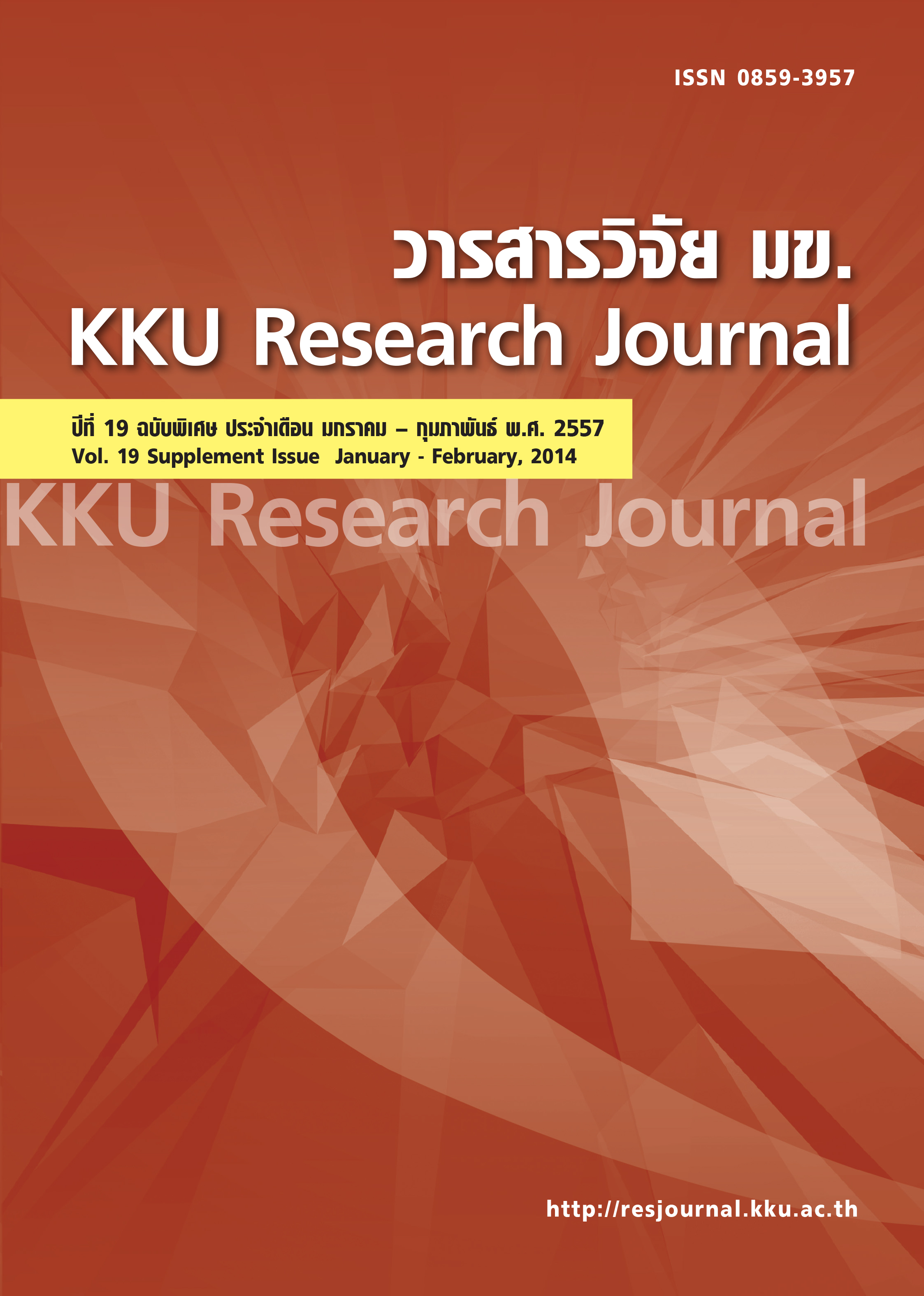Evaluation of agricultural wastes for the use in ethanol production by Candida shehatae TISTR 5843
Main Article Content
Abstract
This study aimed to evaluate four agricultural wastes: rice straw, oil palm empty fruit bunch (oil palm EFB), sugarcane bagasse and corncob, for their potential when used as feedstocks in ethanol production. The waste materials were subjected to acid pretreatment by autoclaving at 121 oC followed by enzyme (Accellerase 1500?) hydrolysis prior to ethanol fermentation. By varying the times in acid pretreatment, 10 minutes was shown to be sufficient based on the test of susceptibility to cellulose hydrolysis. The enzyme dosage study resulted in the use of 60 FPU/g dry solid (DS) for all acid-treated materials except for oil palm EFB which required the dosage of 110 FPU/g DS. Different forms of substrates used in enzyme hydrolysis (the acid-treated solids versus the acid-treated slurries) did not affect the amount of ethanol produced from resulting oil palm EFB and sugarcane bagasse hydrolysates, but they did affect in the case of rice straw and corncob hydrolysates. The fermentation of rice straw, oil palm EFB, sugarcane bagasse and corncob hydrolysates by Candida shehatae TISTR 5843 resulted in 9.8, 9.3, 7.9 and 10.9 g/l of ethanol respectively.
Article Details
References
[2] Kumar P, Barrett DM, Delwiche MJ, Stroeve P. Methods for Pretreatment of Lignocellulosic Biomass for Efficient Hydrolysis and Biofuel Production. Industrial & Engineering Chemistry Research. 2009;48(8):3713-29.
[3] Sun Y, Cheng J. Hydrolysis of lignocellulosic materials for ethanol production: a review. Bioresource Technology. 2002;83(1):1-11.
[4] Balat M. Production of bioethanol from lignocellulosic materials via the biochemical pathway: A review. Energy Conversion and Management. 2011;52(2):858-75.
[5] Wanderley MCdA, Martin C, Rocha GJdM, Gouveia ER. Increase in ethanol production from sugarcane bagasse based on combined pretreatments and fed-batch enzymatic hydrolysis. Bioresource Technology. 2013;128(0):448-53.
[6] Rabelo SC, Amezquita Fonseca NA, Andrade RR, Maciel Filho R, Costa AC. Ethanol production from enzymatic hydrolysis of sugarcane bagasse pretreated with lime and alkaline hydrogen peroxide. Biomass and Bioenergy. 2011;35(7):2600-7.
[7] Cheng K-K, Cai B-Y, Zhang J-A, Ling H-Z, Zhou Y-J, Ge J-P, et al. Sugarcane bagasse hemicellulose hydrolysate for ethanol production by acid recovery process. Biochemical Engineering Journal. 2008;38(1):105-9.
[8] Chen M, Xia L, Xue P. Enzymatic hydrolysis of corncob and ethanol production from cellulosic hydrolysate. International Biodeterioration & Biodegradation. 2007;59(2):85-9.
[9] Singh A, Bishnoi N. Optimization of enzymatic hydrolysis of pretreated rice straw and ethanol production. Applied Microbiology and Biotechnology. 2012;93(4):1785-93.
[10] Nigam JN. Ethanol production from wheat straw hemicellulose hydrolysate by Pichia stipitis. Journal of Biotechnology. 2001;87(1):17-27.
[11] Wan P, Zhai D, Wang Z, Yang X, Tian S. Ethanol Production from Nondetoxified Dilute-Acid Lignocellulosic Hydrolysate by Cocultures of Saccharomyces cerevisiae Y5 and Pichia stipitis CBS6054. Biotechnology Research International. 2012;2012:6.
[12] Cho DH, Shin S-J, Bae Y, Park C, Kim YH. Enhanced ethanol production from deacetylated yellow poplar acid hydrolysate by Pichia stipitis. Bioresource Technology. 2010;101(13):4947-51.
[13] Office of Agricultural Economics [Internet]. Agricultural Economic for the first half and outlook of 2013; 2013 [cited 2013 Jul 30]. Available from: http:/ /www.oae.go.th/download/bapp/halfyear2556.pdf
[14] Miller GL. Use of Dinitrosalicylic Acid Reagent for Determination of Reducing Sugar. Analytical Chemistry. 1959;31(3):426-8.
[15] Fan LT, Lee Y-H, Beardmore DH. Mechanism of the enzymatic hydrolysis of cellulose: Effects of major structural features of cellulose on enzymatic hydrolysis. Biotechnology and Bioengineering. 1980;22(1):177-99.
[16] Jeong TS, Um BH, Kim JS, Oh KK. Optimizing dilute-acid pretreatment of rapeseed straw for extraction of hemicellulose. Applied Biochemistry and Biotechnology. 2010;161(1-8):22-33.
[17] Huang CF, Lin TH, Guo GL, Hwang WS. Enhance ethanol production by fermentation of rice straw hydrolysate without detoxification using a newly adapted strain of Pichia stipitis. Bioresource Technology. 2009;100:3914-3920.
[18] Chen WH, Lin TS, Guo GL, Huang WS. Ethanol production from rice straw hydrolysate by Pichia stipitis. Energy procedia. 2012;14:1261-1266.
[19] Canilha L, Carvalho W, Felipe MGA, Silva JBA, Giulietti M. Ethanol production from sugarcane bagasse hydrolysate using Pichia stipitis. Applied Biochemistry and Biotechnology. 2010;161:84-92.
[20] Chandel AK, Kapoor RK, Singh A, Kuhad RC. Detoxification of sugarcane bagasse hydrolysate improves ethanol production by Candida shehatae NCIM 3501. Bioresource Technology. 2007;101: 4947-4951.
[21] Hsu TC, Guo GL, Chen WH, Hwang WS. Effect of dilute acid pretreatment of rice straw on structural properties and enzymatic hydrolysis. Bioresource Technology. 2010;101(13):4907-13.
[22] Sumphanwanich J, Leepipatpiboon N, Srinorakutara T, Akaracharanya A. Evaluation of dilute-acid pretreated bagasse, corn cob and rice straw for ethanol fermentation by Saccharomyces cerevisiae. Annals of Microbiology. 2008;58(2):219-25.
[23] Huang C-F, Lin T-H, Guo G-L, Hwang W-S. Enhanced ethanol production by fermentation of rice straw hydrolysate without detoxification using a newly adapted strain of Pichia stipitis. Bioresource Technology. 2009;100(17):3914-20.


